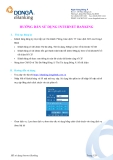
29
© Học viện Ngân hàng
ISSN 3030 - 4199
Tạp chí Kinh tế - Luật & Ngân hàng
Số 277- Năm thứ 27 (5)- Tháng 5. 2025
Tác động của chuyển đổi số đến rủi ro tín dụng và
rủi ro thanh khoản của các ngân hàng thương mại
Việt Nam
Ngày nhận: 15/04/2025 Ngày nhận bản sửa: 10/05/2025 Ngày duyệt đăng: 19/05/2024
Tóm tắt: Trong bối cảnh nền kinh tế toàn cầu ngày càng phát triển mạnh mẽ,
việc ứng dụng công nghệ số vào các hoạt động kinh doanh, đặc biệt là trong
ngành ngân hàng, đã trở thành một yếu tố then chốt giúp các ngân hàng nâng
cao hiệu quả hoạt động, cải thiện chất lượng dịch vụ và gia tăng khả năng
cạnh tranh. Bài viết này sẽ phân tích tác động của chuyển đổi số đối với hai rủi
ro trọng yếu của các ngân hàng thương mại Việt Nam bao gồm rủi ro tín dụng
và rủi ro thanh khoản. Nghiên cứu được thực hiện với 24 ngân hàng thương
mại Việt Nam trong giai đoạn từ năm 2016 đến 2024 bằng phương pháp bình
phương tối thiểu tổng quát (GLS). Kết quả nghiên cứu thực nghiệm cho thấy
chuyển đổi số giúp giảm thiểu rủi ro tín dụng và rủi ro thanh khoản tại các
Impact of digital transformation on credit risk and liquidity risk of Vietnamese commercial banks
Abstract: In an increasingly robust global economy, the digital transformation in business operations,
particularly within the banking sector, has become critical factor in helping banks enhance operational
efficiency, improve service quality, and increase competitive capacity. This paper will analyze the impact
of digital transformation on two material risks faced by Vietnamese commercial banks, namely credit
risk and liquidity risk. The study was conducted with 24 Vietnamese commercial banks from 2016 to
2024 using the Generalized Least Squares (GLS) method. The empirical results demonstrate that digital
transformation contributes to the reduction of both credit risk and liquidity risk at Vietnamese commercial
banks. In adition, the positive impact of digital transformation is more significant for listed banks, with the
positive effects being particularly evident in various aspects of digital transformation, including technical
infrastructure, human resource infrastructure, internal applications, and online services. Therefore, the
study offers several recommendations for Vietnamese commercial banks to proactively implement digital
transformation strategies, including the development of digital infrastructure and technology systems,
digital banking products and services, digital human resources, and the digitization of internal processes.
Keywords: Digital transformation, Credit risk, Liquidity risk
Doi: 10.59276/JELB.05.2941
Nguyen, Thi Thu Trang
Email: trangntt@hvnh.edu.vn
Organization: Banking Academy of Vietnam
Nguyễn Thị Thu Trang
Học viện Ngân hàng, Việt Nam

Tác động của chuyển đổi số đến rủi ro tín dụng và rủi ro thanh khoản của
các ngân hàng thương mại Việt Nam
30 Tạp chí Kinh tế - Luật & Ngân hàng- Số 277- Năm thứ 27 (5)- Tháng 5. 2025
ngân hàng thương mại Việt Nam. Bên cạnh đó, tác động tích cực của chuyển
đổi số có ý nghĩa hơn đối với các ngân hàng niêm yết, đồng thời tác động tích
cực được minh chứng ở các cấu phần của chuyển đổi số bao gồm hạ tầng kỹ
thuật, hạ tầng nhân lực, ứng dụng nội bộ và dịch vụ trực tuyến. Từ đó, nghiên
cứu đưa ra một số khuyến nghị đối với các NHTM Việt Nam trong việc triển
khai tích cực chiến lược chuyển đổi số, bao gồm phát triển cơ sở hệ thống hạ
tầng và công nghệ số, sản phẩm dịch vụ ngân hàng số, nguồn nhân lực số và
số hóa quy trình nội bộ.
Từ khóa: Chuyển đổi số, Rủi ro tín dụng, Rủi ro thanh khoản
1. Giới thiệu
Trong hoạt động của các ngân hàng thương
mại (NHTM), rủi ro tín dụng và rủi ro
thanh khoản luôn đóng vai trò quan trọng
trong việc bảo đảm sự ổn định và an toàn
của hệ thống tài chính. Sau cuộc khủng
khoảng tài chính, phần lớn các ngân hàng
trên toàn thế giới tập trung chủ yếu vào rủi
ro tín dụng vì được đánh giá là trọng yếu
nhất trong hoạt động ngân hàng (Leung và
cộng sự 2015). Bên cạnh đó, rủi ro thanh
khoản nếu không được quản lý chặt chẽ sẽ
làm suy giảm lợi nhuận và ổn định của hệ
thống ngân hàng (Chen và cộng sự 2018).
Trong giai đoạn chuyển đổi số ngày càng
diễn ra mạnh mẽ tại Việt Nam, ngành ngân
hàng không chỉ đối mặt với cơ hội cải tiến
quy trình làm việc và dịch vụ khách hàng,
mà còn phải đối mặt với những thách thức
mới về quản lý rủi ro. Chuyển đổi số không
chỉ mang đến các công cụ mới trong việc
xử lý dữ liệu, tự động hóa và tối ưu hóa
dịch vụ, mà còn tác động đến các yếu tố
cấu thành rủi ro trong ngân hàng, đặc biệt
là rủi ro tín dụng và rủi ro thanh khoản.
Trong khi chuyển đổi số giúp nâng cao
năng lực quản lý và giảm chi phí, các ngân
hàng cũng phải đối mặt với những rủi ro
tiềm ẩn từ việc áp dụng công nghệ mới vào
các quy trình cho vay, quản lý nguồn vốn,
bảo mật thông tin và tương tác với khách
hàng (Shanti và cộng sự 2022).
Trong bối cảnh đó, nghiên cứu về tác động
của chuyển đổi số đến rủi ro tín dụng và rủi
ro thanh khoản trở nên đặc biệt quan trọng.
Mặc dù có nhiều nghiên cứu đề cập đến các
yếu tố tác động của công nghệ hay chuyển
đổi số đến ngành ngân hàng (Chen và cộng
sự, 2023; Hoque và cộng sự, 2024; Nguyễn
Văn Thủy, 2022; Phạm Thủy Tú và cộng
sự, 2023), nhưng việc phân tích cụ thể
tác động của chuyển đổi số đến rủi ro tín
dụng và rủi ro thanh khoản tại các NHTM
Việt Nam vẫn còn khá hạn chế. Phần lớn
các nghiên cứu tại Việt Nam đánh giá tác
động của chuyển đổi số đến rủi ro chung
của ngân hàng qua hệ số Z-score thay vì
đánh giá sâu các rủi ro trọng yếu trong
hoạt động ngân hàng, cũng như hiện chưa
nhiều nghiên cứu phân tích sâu tác động
của chuyển đổi số thông qua các cấu phần
của chuyển đổi số.
Bài viết được thực hiện nhằm đánh giá
tác động của chuyển đổi số tới hai rủi ro
trọng yếu trong hoạt động của các NHTM
Việt Nam bao gồm rủi ro tín dụng và rủi
ro thanh khoản. Bên cạnh đó, nghiên cứu
cũng thực hiện đánh giá tác động của các
cấu phần của chuyển đổi số (bao gồm hạ
tầng kỹ thuật, hạ tầng nhân lực, ứng dụng
công nghệ thông tin nội bộ và dịch vụ trực
tuyến) tới rủi ro tín dụng và rủi ro thanh
khoản của các NHTM Việt Nam. Bài viết

NGUYỄN THỊ THU TRANG
31
Số 277- Năm thứ 27 (5)- Tháng 5. 2025- Tạp chí Kinh tế - Luật & Ngân hàng
được kết cấu bao gồm 5 phần: Phần 1- Giới
thiệu, Phần 2- Tổng quan nghiên cứu, Phần
3 Phương pháp nghiên cứu, Phần 4- Kết
quả nghiên cứu và thảo luận, Phần 5- Kết
luận và khuyến nghị.
2. Tổng quan nghiên cứu
2.1. Tổng quan về chuyển đổi số và tác
động của chuyển đổi số trong lĩnh vực
ngân hàng
Chuyển đổi số (Digital Transformation)
được hiểu là quá trình ứng dụng công
nghệ số vào tất cả các khía cạnh của doanh
nghiệp, thay đổi cách thức hoạt động, mô
hình kinh doanh và giá trị cung cấp cho
khách hàng (Warner & Wäger, 2019). Quá
trình này không chỉ dừng lại ở việc áp dụng
công nghệ mà còn liên quan đến việc thay
đổi tư duy và văn hóa tổ chức nhằm tối ưu
hóa hiệu quả hoạt động và tạo ra những cơ
hội mới. Chuyển đổi số trong ngân hàng
do vậy được hiểu là việc triển khai và đổi
mới các dịch vụ tài chính ngân hàng cũng
như những đột phá sáng tạo trong hoạt
động ngân hàng (Krasonikolakis và cộng
sự 2020). Theo Naimi-Sadigh và cộng sự
(2022), chuyển đổi số trong ngân hàng bao
gồm 5 khía cạnh: nhân sự, quy trình, công
nghệ, thông tin và trạng thái dữ liệu. Trong
khi đó Rogers (2016) lại cho rằng chuyển
đổi số trong ngân hàng cần đảm bảo khách
hàng truy cập được các dịch vụ ngân hàng
thông qua các kênh số; các sản phẩm, dịch
vụ ngân hàng số; tích hợp công nghệ và cơ
sở hạ tầng.
Nhiều nghiên cứu đã tập trung vào tác động
của chuyển đổi số trong lĩnh vực ngân hàng
Shanti và cộng sự (2022). Các nghiên cứu
cho rằng chuyển đổi số trong ngân hàng sẽ
tạo ra những sản phẩm dịch vụ mới, mang
đến trải nghiệm tốt hơn cho khách hàng do
gia tăng tương tác với khách hàng Tran và
cộng sự (2023). Bên cạnh đó, chuyển đổi số
được minh chứng giúp đơn giản và tối ưu
hóa các hoạt động ngân hàng truyền thống,
cải thiện hiệu suất của hoạt động quản lý,
tăng hiệu quả sử dụng nguồn lực, giảm
thiểu chi phí vận hành trong ngân hàng, từ
đó giúp nâng cao hiệu quả hoạt động và
đảm bảo sự phát triển bền vững của ngân
hàng (Al-Busaidi & Al-Muharrami, 2021;
Artemenko & Zenchenko, 2021; Do và
cộng sự 2022); từ đó giúp gia tăng khả năng
cạnh tranh của các ngân hàng trước các đối
thủ cạnh tranh (Hadi & Hmood, 2020; Jia
& Liu, 2024).
Tuy nhiên, không phải tất cả các nghiên
cứu đều khẳng định rằng chuyển đổi số chỉ
mang lại lợi ích cho các ngân hàng. Wang
và cộng sự (2024) cho rằng chuyển đổi
số có thể gia tăng sự phụ thuộc vào công
nghệ và hệ thống mạng, làm gia tăng rủi
ro an ninh mạng và quyền riêng tư về dữ
liệu. Chuyển đổi số trong ngân hàng có thể
tạo ra các rủi ro công nghệ và rủi ro hoạt
động mới cho ngân hàng Tang và cộng
sự (2020). Bên cạnh đó, chuyển đổi số có
thể khiến các ngân hàng thay đổi trong mô
hình hoạt động, cơ cấu tổ chức từ đó dẫn
đến những thay đổi trong kiểm soát nội bộ
và quản trị rủi ro của ngân hàng (Heavin &
Power, 2018).
2.2. Tác động của chuyển đổi số đến rủi
ro tín dụng và rủi ro thanh khoản ngân
hàng
Quá trình chuyển đổi số tác động không nhỏ
tới rủi ro và hoạt động quản lý rủi ro của
các NHTM. Nghiên cứu của Chen và cộng
sự (2023) về các ngân hàng tại Trung Quốc
cho thấy chuyển đổi số làm giảm đáng kể
việc chấp nhận rủi ro của các NHTM, được
lý giải do chuyển đổi số giúp giảm thiểu
rủi ro hoạt động và lỗi do con người gây
ra. Tương tự, Hoque và cộng sự (2024) cho

Tác động của chuyển đổi số đến rủi ro tín dụng và rủi ro thanh khoản của
các ngân hàng thương mại Việt Nam
32 Tạp chí Kinh tế - Luật & Ngân hàng- Số 277- Năm thứ 27 (5)- Tháng 5. 2025
rằng chính sự cải thiện trong hiệu quả hoạt
động và khả năng sinh lời do chuyển đổi số
đã giúp các ngân hàng hạn chế rủi ro trong
quá trình vận hành. Các nghiên cứu khác
cũng đưa ra kết luận tương tự như nghiên
cứu của (Banna và cộng sự 2021; Daud và
cộng sự 2022; Jia & Liu, 2024).
Có một số nghiên cứu hiện đã bắt đầu chỉ
ra những tác động sâu sắc của chuyển đổi
số đến các rủi ro cụ thể và trọng yếu của
ngân hàng, trong đó có rủi ro tín dụng và
rủi ro thanh khoản. Rủi ro tín dụng liên
quan đến khả năng khách hàng không thể
trả nợ theo các cam kết tín dụng (Switzer &
Wang, 2013). Các ngân hàng đã ứng dụng
công nghệ trong tất cả các giai đoạn của
quy trình tín dụng bao gồm giai đoạn phát
triển khách hàng, khởi tạo khoản vay, thẩm
định tín dụng, giải ngân, thu nợ và quản
lý khách hàng (Nguyễn Thị Thu Trang và
cộng sự, 2024). Theo Mohsen và cộng sự
(2024) việc tự động hóa các quy trình tín
dụng có thể giúp giảm thiểu sự can thiệp
của con người, từ đó hạn chế sai sót và
nâng cao tính minh bạch. Việc sử dụng
AI và học máy hỗ trợ hoạt động khai thác
thông tin về khách hàng, thông tin tín dụng
và hoạt động phân tích khả năng trả nợ
của khách hàng, từ đó cải thiện tình trạng
bất cân xứng thông tin và giúp giảm thiểu
rủi ro tín dụng (Malladi và cộng sự 2021;
Zhang và cộng sự 2023). Bên cạnh đó, ứng
dụng công nghệ giúp các ngân hàng giúp
sàng lọc giao dịch của khách hàng nhằm
phát hiện sớm rủi ro tín dụng, tăng cường
hiệu quả quản trị rủi ro và kiểm soát nội bộ
(Khattak và cộng sự 2023)
Rủi ro thanh khoản trong ngân hàng đề cập
đến khả năng của ngân hàng trong việc đáp
ứng các nghĩa vụ tài chính mà không gặp
khó khăn (Arif & Nauman Anees, 2012).
Chuyển đổi số có thể ảnh hưởng đến khả
năng duy trì thanh khoản của ngân hàng
thông qua các thay đổi trong cơ cấu dòng
tiền và hành vi của khách hàng. Công nghệ
hiện đại giúp ngân hàng cung ứng nhiều sản
phẩm và dịch vụ tài chính ngân hàng linh
hoạt hơn cho khách hàng, do vậy khách
hàng có thể tiếp cận với nguồn vốn nhanh
hơn và dễ dàng hơn trong các tình huống
cần thanh khoản. Bên cạnh đó, chuyển đổi
số giúp giảm thiểu hạn chế về địa lý khiến
các ngân hàng gia tăng lượng khách hàng
gửi tiền, từ đó tăng cường thanh khoản cho
ngân hàng (Musau, 2022). Ngược lại, Wu
và cộng sự (2023) cho rằng trong giai đoạn
chuyển đổi số, ngân hàng chịu áp lực cạnh
tranh với các công ty fintech do vậy gây
thách thức đối với khả năng thu hút tiền
gửi từ người dân, bên cạnh đó, ngân hàng
tăng cường cho vay các doanh nghiệp vừa
và nhỏ bằng cách áp dụng các điều khoản
thuận lợi hơn, do vậy làm suy giảm thanh
khoản và gia tăng rủi ro thanh khoản ngân
hàng. Tuy nhiên nghiên cứu của Hoque và
cộng sự (2024) lại cho rằng chuyển đổi số
tác động làm tăng cả bên tài sản và bên nợ
của bảng cân đối, do vậy không làm suy
giảm thanh khoản của các NHTM.
Tại Việt Nam đã có một số nghiên cứu
quan tâm tới hoạt động chuyển đổi số trong
lĩnh vực ngân hàng. Chuyển đổi số tại các
NHTM Việt Nam được minh chứng tác
động tích cực tới hiệu quả hoạt động ngân
hàng (Trịnh Đoàn Tuấn Linh, 2024), nâng
cao khả năng sinh lời ngân hàng (Nguyen
và cộng sự 2023) từ đó nâng cao năng lực
cạnh tranh của các ngân hàng (Nguyễn
Thị Như Quỳnh, 2023; Nguyễn Văn Thủy,
2022). Đã có một số nghiên cứu đề cập tới
tác động của chuyển đổi số đến rủi ro ngân
hàng Việt Nam nói chung như nghiên cứu
của Cù Thị Hà Trang và cộng sự (2024) từ
đó giúp ổn định hệ thống ngân hàng (Phạm
Thủy Tú và cộng sự 2023). Về khía cạnh
các rủi ro trọng yếu trong hoạt động ngân
hàng nghiên cứu của (Nguyễn Thị Thiều
Quang, 2023) cho rằng chuyển đổi số tại

NGUYỄN THỊ THU TRANG
33
Số 277- Năm thứ 27 (5)- Tháng 5. 2025- Tạp chí Kinh tế - Luật & Ngân hàng
các NHTM Việt Nam hiện đang tập trung
chủ yếu cho trải nghiệm khách hàng và tác
động làm tăng rủi ro tín dụng, trong khi đó
Nguyen và Nguyen (2024) đã minh chứng
quan điểm ngược lại khi cho rằng chuyển
đổi số giúp giảm thiểu rủi ro tín dụng của
các NHTM Việt Nam. Như vậy, mặc dù
đã có một số nghiên cứu đã đề cập đến tác
động chuyển đổi số đến rủi ro ngân hàng
Việt Nam tuy nhiên số lượng nghiên cứu
về tác động tới rủi ro tín dụng ngân hàng
còn hạn chế và trái chiều, cũng như trong
sự hiểu biết của tác giả chưa có nghiên cứu
về tác động tới rủi ro thanh khoản ngân
hàng. Bên cạnh đó, tác động của chuyển
đổi số đối với rủi ro tín dụng và thanh
khoản, nhưng việc nghiên cứu tác động cụ
thể hơn tại các NHTM Việt Nam với các
nhóm ngân hàng khác nhau và tác động của
các khía cạnh khác nhau của chuyển đổi số
cần được tiếp tục nghiên cứu.
3. Phương pháp nghiên cứu
3.1. Mô hình nghiên cứu
Để đánh giá tác động của chuyển đổi số
đến rủi ro tín dụng và rủi ro thanh khoản
tại các NHTM Việt Nam, dựa trên nghiên
cứu của Hoque và cộng sự (2024) mô hình
nghiên cứu được đề xuất:
NPLi,t = β
0 + β
1DTRi,t + β
2SIZEi,t + β
3
LEVi,t + β4LDRi,t + β5ROAi,t + β6INFt +
β7GDPt + τi + μt + εi,t (1)
LIIi,t = β0 + β1DTRi,t + β2SIZEi,t + β3 LEVi,t
+ β4LDRi,t + β5ROAi,t + β6INFt + β7GDPt
+ τi + μt + εi,t (2)
Trong đó:
- NPLi,t Biến phụ thuộc đo lường rủi ro tín
dụng của ngân hàng thông qua tỷ lệ dư nợ
xấu trên tổng dư nợ, tương tự như đo lường
rủi ro tín dụng trong nghiên cứu của Lê Hải
Trung (2023).
- LIIi,t Biến phụ thuộc đo lường rủi ro
thanh khoản, bằng tỷ lệ nợ có trọng số theo
kì hạn trên tỷ lệ tài sản có trọng số theo
kì hạn, tương tự nghiên cứu của Vazquez
và Federico (2015). Theo đó tỷ lệ thanh
khoản càng cao, ngân hàng càng gặp ít rủi
ro thanh khoản hơn.
- DTRi,t là biến nghiên cứu chính, đại diện
cho mức độ chuyển đổi số của các NHTM
Việt Nam được thu thập từ báo cáo thường
niên của Bộ Thông tin và Truyền thông,
tương tự như nghiên cứu của (Nguyễn Văn
Thủy, 2022).
Các biến kiểm soát bao gồm các biến đặc
trưng của ngân hàng và các biến vĩ mô tác
động tới rủi ro tín dụng và rủi ro thanh
khoản của các NHTM Việt Nam. Các biến
kiểm soát trong mô hình được kế thừa từ
các nghiên cứu đi trước (Chen và cộng sự,
2023; Hoque và cộng sự, 2024; Megginson,
2005) bao gồm:
- SIZE: Quy mô ngân hàng, bằng logarithm
tổng tài sản của NHTM;
- LEV: Hệ số đòn bẩy, bằng tỷ lệ vốn chủ
trên tổng tài sản;
- LDR: Tỷ lệ cho vay trên tiền gửi;
- ROA: Tỷ lệ lợi nhuận trên tài sản bình
quân;
- INF: Tỷ lệ lạm phát
- GDP: Tỷ lệ tăng trưởng.
Các dữ liệu được lấy theo ngân hàng (i) và
thời gian (t), bên cạnh đó và thể hiện là
hiệu ứng cố định theo ngân hàng và theo
thời gian để kiểm soát cho các tác động nội
sinh riêng biệt của mỗi ngân hàng, là sai số
trong mô hình nghiên cứu.
3.2. Dữ liệu nghiên cứu và phương pháp
phân tích
Mẫu nghiên cứu được lựa chọn dựa trên
khả năng tiếp cận số liệu được công bố sẵn
có của các yếu tố trong mô hình nghiên
cứn. Mẫu dữ liệu bảo đảm tính đại diện
cho các NHTM Việt Nam với tỷ trọng tài







![Giải pháp Ngân hàng điện tử: Tài liệu [mô tả/hướng dẫn/kinh nghiệm]](https://cdn.tailieu.vn/images/document/thumbnail/2012/20120730/cvbn123/135x160/1220052_159.jpg)
![Lý Thuyết Tín Dụng Ngân Hàng: Sơ Đồ Quy Trình Tín Dụng Chung [Chi Tiết]](https://cdn.tailieu.vn/images/document/thumbnail/2011/20111026/abcdef_44/135x160/so_do_quy_trinh_tin_dung_chung_6351.jpg)
















